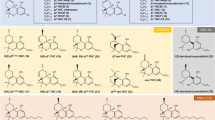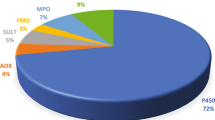Summary
In vivo metabolism of 1-methyl-1,2,3,4-tetrahydro-β-carboline-l-carboxylic acid (1-CTHH), a possible precursor of the endogenous β-carbolines tetrahydroharman (THH) and harman was investigated in rats. Following intraperitoneal injection of [4-14C]1-CTHH, a rapid distribution of the radioactivity in the tissues was observed. The highest radioactivity was measured in the kidney and the lowest in the brain as well as in the fat tissue. Approximately 55% of the administered dose was excreted in the urine within 90 min. The radioactivity in the urine consisted of unchanged 1-CTHH (> 90%) besides harmalan and trace amounts of harman. Harmalan represents the major degradation product of 1-CTHH; it could be identified in all tissues examined and in the urine. The concentration in the blood, however, was low at all time points investigated. The peak concentration of harmalan in most tissues was measured between 15–30 min after injection. A time-dependent formation of THH was found in the lung and spleen indicating an important role of these organs in the biosynthesis of THE Furthermore, the metabolism of [4-14C]1-CTHH in the brain was studied following intracerebroventricular injection. The formation of harmalan in the brain was not affected by pretreatment with the aromatic amino acid decarboxylase inhibitor NSD 1015. Determination of the harmalan concentration in several brain regions revealed a high level in the hippocampus and hypothalamus and a small concentration in pons, corpus striatum, cerebellum and cerebal cortex 20 min after injection. The analyses of the radiolabelled compounds were performed by thin-layer chromatography and the identification was further confirmed by high-performance liquid chromatography. The results suggest that 1-CTHH can serve as a precursor of the endogenous β-carbolines. The in vivo conversion of the compound proceeds mainly via an oxidative decarboxylation.
Similar content being viewed by others
Abbreviations
- BC:
-
β-carboline
- 1-CTHH:
-
1-methyl-1,2,3,4-tetrahydro-β-carboline-l-carboxylic acid
- HPLC:
-
high performance liquid chromatography
- i.c.v.:
-
intracerebroventricular
- i.p.:
-
intraperitoneal
- PLP:
-
pyridoxal-5′-phosphate
- THH:
-
tetrahydroharman
- TLC:
-
thin layer chromatography
References
Airaksinen MM, Kari I (1981) β-Carbolines, psychoactive compounds in mammalian body. Part I. Occurrence, origin and metabolism. Med Biol 59:21–34
Allen JRF, Beck O, Borg S, Skröder R (1980) Analysis of 1-methyl-1,2,3,4-tetrahydro-β-carboline in human urine and cerebrospinal fluid by gas chromatography-mass spectrometry. Eur J Mass Spectrom Biochem Med Environ Res 1:171–177
Allen JRF, Holmstedt BR (1980) The simple β-carboline alkaloids. Phytochemistry 19:1573–1582
Bobbitt JM, Kulkarni CL, Wiriyachitra P (1976) Decarboxylation of phenolic tetrahydroisoquinoline-l-carboxylic acids in air. Heterocycles 4:1645–1648
Buckholtz NS (1980) Neurobiology of tetrahydro-β-carbolines. Life Sci 27:893–903
Carlsson A (1964) Functional significance of drug-induced changes in brain monoamine levels. In: Himwich HE, Himwich WA (eds) Progress in brain research, vol 8. Elsevier, Amsterdam London New York, pp 9–27
Collins MA, Dahl K, Nijm W, Major LF (1982) Evidence for homologous families of dopamine and serotonin condensation products in CSF of monkeys. Soc Neurosci 8:277
Coutts IGC, Hamblin MR, Tinley EJ, Bobbitt JM (1979) The enzymatic oxydation of phenolic tetrahydroisoquinoline-1-carboxylic acids. J Chem Soc Perkin 1:2744–2750
Fujishima M, Ogata J, Oniki H, Onoyama K, Morotomi K, Omae T (1978) Lactate, pyruvate and ATP concentrations of the brain in two models of hypertension in rats. Brain Res 152:189–195
Gynther J, Lapinjoki SP, Airaksinen MM, Peura P (1986) Decarboxylation of 1,2,3,4-tetrahydro-β-carboline-l-carboxylic acids in brain homogenate and catalysis by pyridoxal-5′-phosphate. Biochem Pharmacol 35:2671–2675
Kapadia GJ, Rao GS, Leete E, Fayez MBE, Vaishnav YN, Fales HM (1970) On the origin of carbon 1 in tetrahydro-isoquinoline alkaloids. J Amer Chem Soc 92:6943–6951
Peura P, Kari I, Airaksinen MM (1980) Identification by selective ion monitoring of 1-methyl-1,2,3,4-tetrahydro-β-carboline in human platelets and plasma after ethanol intake. Biomed Mass Spectrom 7:553–555
Rommelspacher H, Strauss S, Lindemann J (1980) Excretion of tetrahydroharman and harman into the urine of man and rat after a load with ethanol. FEBS Lett 109:209–212
Rommelspacher H, Brüning G, Susilo R, Nick M, Hill R (1985) Pharmacology of harmalan (1-methyl-3,4-dihydro-1-carboline). Eur J Pharmacol 109:363–371
Shoemaker DW, Cummins JT, Bidder TG, Boettger HG, Evans M (1980) Identification of harman in the rat arcuate nucleus. Naunyn-Schmiedeberg's Arch Pharmacol 310:227–230
Susilo R, Rommelspacher H (1987) Formation of a β-carboline (1,2,3,4-tetrahydro-l-methyl-β-carboline-l-carboxylic acid) following intracerebroventricular injection of tryptamine and pyruvic acid. Naunyn-Schmiedeberg's Arch Pharmacol 335:70–76
Susilo R, Damm H, Rommelspacher H, Höfle G (1987) Biotransformation of 1-methyl-1,2,3,4-tetrahydro-β-carboline-l-carboxylic acid to harmalan, tetrahydroharman and harman in rats. Neurosci Lett 21:325–330
Zeman W, Innes JRM (1963) Craigies's neuroanatomy of the rat. Academic Press, New York
Author information
Authors and Affiliations
Additional information
Send offprint requests to R. Susilo at the above address
Rights and permissions
About this article
Cite this article
Susilo, R., Rommelspacher, H. Formation of 1-methyl-β-carbolines in rats from their possible carboxylic acid precursor. Naunyn-Schmiedeberg's Arch Pharmacol 337, 566–571 (1988). https://doi.org/10.1007/BF00182733
Received:
Accepted:
Issue Date:
DOI: https://doi.org/10.1007/BF00182733




